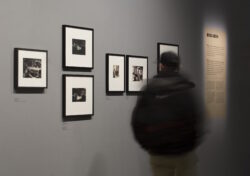In the countryside at night, there is the spectacle of stars in the sky. What I saw in contrast when I arrived in Cali were that the stars were on earth.Fernell Franco

Fernell Franco first came to photography out of necessity. Displaced as a child by the bipartisan violence that raged in Colombia between 1948 and 1953, he was among the thousands who had fled the countryside to settle in Cali’s poor marginalized neighborhoods. He began working at a young age and learned photography on the job as a messenger in a photographic studio, then as a fotocinero taking pictures of people in the streets. In 1962, he was hired as a photojournalist for El País and Diario Occidente and later worked as a fashion and advertising photographer for magazines such as Diners and Elite. As a photojournalist, he came into daily contact with the violence and inequalities of Colombian society, documenting urban uprisings and rural massacres, as well as the cocktail parties of Cali’s elite.
During this period, the city of Cali was undergoing a period of tremendous growth and transformation, spurred by the influx of rural migrants who had, like Franco, been displaced by La Violencia as well as by the developmentof the sugar industry. At the same time, an incredibly vital artistic community emerged, transforming what was once a peripheral city into an important cultural center. Introduced to the realmof art and culture through his work as a photojournalist, Franco would become a part of this vibrant art scene which included the talented writer Andrés Caicedo, filmakers Luis Ospina and Carlos Mayolo and artists Ever Astudillo and Oscar Muñoz, sharing with them a fascination for popular culture and an interest in urban themes that had previously been unexplored in Colombian art, film and literature.
I was searching for common things—things that took place in the city on a daily basis that happened in the lives of normal people. Something to differentiate it from the work I had been doing in advertising and fashion photography.Fernell Franco

Driven by a search for personal expression, Fernell Franco produced many extraordinary series that documented marginalized communities, urban destruction and transformation and addressed issues such as violence and displacement. However, his style differs greatly from that of the social documentary photography, predominant in Latin America at the time, where the image must convey a direct message. His visual language is not explicit but suggestive, composed of crumbling ruins (Demoliciones), deserted aquatic landscapes (Pacífico), wrapped parcels (Amarrados), bicycles (Bicicletas), architecture and its spaces (Interiores, Billares, Color Popular). Giving prominence to the expressive quality of his photographs, he plays on the contrast between light and shadow or on accentuating the grain of his prints, sometimes drawing directly on its surface using pencil or airbrush.

Influenced by the chiaroscuro effects of film noir and the aesthetic of Italian Neorealism, which he discovered asa child in the movie theatres of Cali, his works have a cinematographic quality, frequently incorporating elements of narration and time.
Among his most celebrated series presented in the exhibition is Prostitutas (1970), a group of black-and-white photographs of women and girls working in one of the last brothels of Buenaventura, a declining city that had once been a prosperous port. Deliberately choosing black and white and employing photomontage to create repetition—a process that the photographer relates to filmmaking—he builds a narrative that conveys the reality of the daily lives of the prostitutes while suggesting a feeling of claustrophobia.
The series Interiores, Billares and Demoliciones explore the rapid modernization, urbanization and destruction of downtown Cali.
For Interiores (which marks the beginning of Fernell Franco’s collaboration with Oscar Muñoz) Fernell Franco photographed the formerly majestic interiors of abandoned old mansions that had been turned into tenements for poor and displaced people. In Billares, Fernell sought to capture the spirit of Cali’s old pool halls, important places of sociability and leisure—that were undergoing demolition to be replaced by more “modern” soda bars.
In the series Demoliciones, the photographer recorded the destruction of Cali’s architectural heritage by drug-related violence, focusing his camera on the city’s buildings in ruin. By photographing these emotionally charged sites, Fernell Franco not only speaks of violence and displacement but also the difficulty of preserving a nation’s collective memory.
Contrary to many of his contemporaries who continued to work in a more traditional photographic style, Fernell Franco’s vision lies somewhere between photography, film, and painting, closing the divide between photography and art. Expanding the limits of what could be considered photography, he transcended the documentary image in search of personal meaning, offering us a subjective experience of the contemporary world.







